Pros
Cons
Introduction
Tour
{{section_header}}{{section.name}}{{/section_header}}




LCD & Viewfinder
{{section_header}}{{section.name}}{{/section_header}}
The LCD screen of the E-5 is an attractive one, with a 3-inch LCD Hypercrystal panel with about 920k pixels. It definitely shows, with an attractive, sharp look to images with good color. The screen also flips out and rotates, so you can hold the camera above your head or at waist level and shoot. The screen also rotates on the pivoting arm, so you can use it for self-portraits and the like.

On the top of the camera is a secondary LCD screen, which shows text information such as the shooting mode, shutter speed, battery status, etc. Although much of this is mirroed on the main screen and in the viewfinder, this is useful for those who like to shoot from the waist, or want to use the entire main LCD screen to see the image preview.

Above the LCD screen of the E-5 is an optical viewfinder. In common with most SLRs, this optical viewfinder shows you exactly what the camera itself will see by bouncing the light from the lens up through a mirror. A strip at the bottom of the viewfinder shows you shooting data such as shutter speed, aperture, battery level, etc.

Flash
{{section_header}}{{section.name}}{{/section_header}}
There are two options for flash: a small built-in pop-up flash, or attaching an external flash to the standard hot shoe. The built-in flash is rather small, but it should have the enough power to help fill in with a portrait or casual shoot. We were not able to test it extensively, but Olympus claims that it has a guide number of 18, which makes it a little more powerful than most.

Lens & Sensor
{{section_header}}{{section.name}}{{/section_header}}

Jacks, Ports & Plugs
{{section_header}}{{section.name}}{{/section_header}}
The E-5 is a well connected camera, with a large number of ports and sockets on the left side of the camera body under a rubber seal. Here, there are connectors for an external microphone, a mini HDMI port, a USB port, remote control connector and a power input.
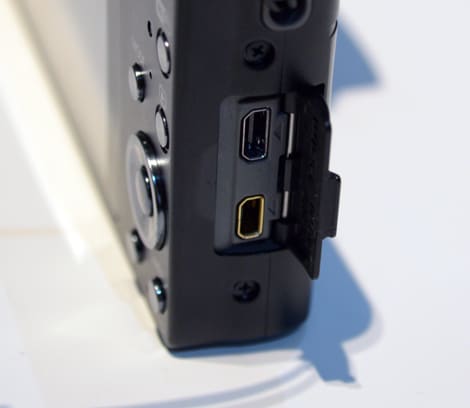
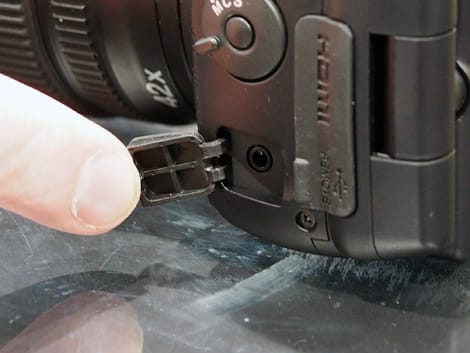
Battery
{{section_header}}{{section.name}}{{/section_header}}
The E-5 gets its power from the BLM-5 li-ion battery that fits into the bottom of the camera. This can hold about TK mAh of power, which Olympus claims will last for about 870 shots when using the optical viewfinder. They did not release a figure for using the screen or the live view mode, but we would expect it to be significantly less.

Memory
{{section_header}}{{section.name}}{{/section_header}}
The E-5 is rare in offering two different types of memory card slots: it has both an SD/SDHC Card slot and a CompactFlash slot. You can switch between them in the on-screen menu, but you cannot use both simultaneously: you have to choose one or the other.
{{product.manufacturer_specs['FI Memory Photo']}}
Other Hardware
{{section_header}}{{section.name}}{{/section_header}}
Electronic Level- The E-5 includes an electronic level that tells you if you are holding the camera level by adding two indicators on the left side and bottom of the screen.
Ease of Use
{{section_header}}{{section.name}}{{/section_header}}
Like all pro cameras, the E-5 is not an easy camera to use. But it began to feel comfortable after a few minutes of use, with the fingers finding the controls more instinctively. Although we only got to try it for a short time, we quickly found ourselves shifting the ISO and other features without having to think about it too much.

The E-5 also offers a very usable live view mode, which flips the mirror up and displays the preview image on the LCD screen. Although this is not the primary mode for this camera, it does offer a good amount of control over the camera, with the auto focus still being quite snappy and a number of nice touches like a live preview of the white balance setting. This mode also allows the use of a simplified on-screen menu which shows the live image and the options available around it.
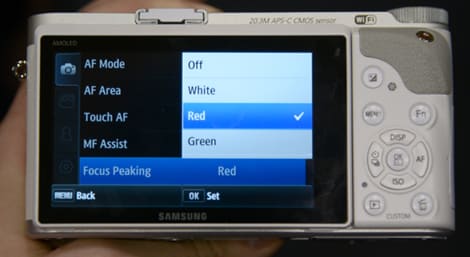

Size & Handling
{{section_header}}{{section.name}}{{/section_header}}
The E-5 is a large camera, but it fits into the hand well, with the grip for the left hand being large and comfortable. It is rather heavy, though, at 31 ounces for the camera alone. Add on a large lens, like the 12-60mm lens shown here (which weighs another 20 ounces), and you are getting into the heavyweight camera class. But it is also a heavyweight that will take a punch well: the camera feels very tough, with a solid feeling metal frame and rubber seals around the case and over the ports.
In use, the camera sits well into the hand, although it really requires two hands to use, like most SLRs. The layout of buttons puts most of the controls within easy reach: the index finger can reach the shutter, ISO and light buttons, while the thumb on the back of the camera can use the AEL/AFL lock button, the control wheel, the function button and the focus point control with ease. This means that you could control many of the features of the camera without taking your eye away from the viewfinder, although you would need to look away and move the hand to do things like change the white balance or access the on-screen menu.

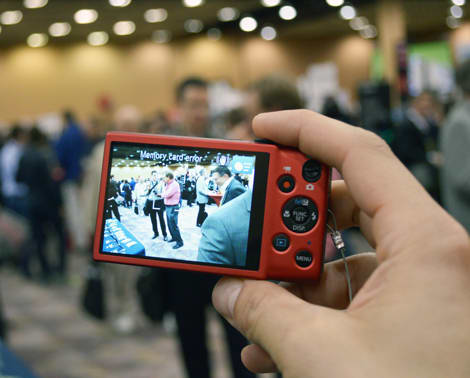
Auto Mode
{{section_header}}{{section.name}}{{/section_header}}
Pressing the mode button allows you to scroll through the list of modes supported by the camera, and this includes a full auto mode, where the only thing the user gets to control is the image size and the flash mode. The auto mode is also the only mode where the Art Filter effects can be applied.
The E-5 also offers the widest selection of bracketing features that we have seen for some time. The camera allows you to automatically take a group of shots with a range of settings for exposure, white balance, flash and ISO level. The only one missing that might be useful is focus bracketing.
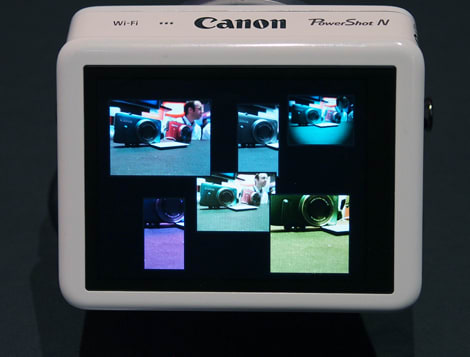
Movie Mode
{{section_header}}{{section.name}}{{/section_header}}
One of the upgrades from previous models is the addition of high definition movie capture, but this is only at 720p (1280 by 720) resolutions, while many of the other cameras announced at the same time are now capturing 1080p resolution video. Still, the E-5 does capture the full 30 progressive frames per second, which some others do not. An option for capturing standard definition (640 by 480) video is also available.
A mono microphone is built into the camera body, but the microphone input allows you to connect a better external microphone. The sound recorded is in stereo with a stereo microphone. Video clips are limited to 7 minutes for HD and 14 minutes for standard definition. After that time, the image sensor has to cool down, so this camera would not work for videoing long performances.
Playback Mode
{{section_header}}{{section.name}}{{/section_header}}
When playing back images, the E-5 offers the ability to zoom in up to 14x, zoom out to view up to 100 thumbnails and to create simple slideshows. Images can also be edited, with the ability to crop, rotate, adjsut shadows and highlights plus a handful of color editing tools, such as saturation.
Custom Image Presets
{{section_header}}{{section.name}}{{/section_header}}
The E-5 does not offer scene modes, but you do get a number of color modes that affect the final image, such as Vivid, Natural, Portrait, Muted and Monotone.
Drive/Burst Mode
{{section_header}}{{section.name}}{{/section_header}}
Olympus claims that the E-5 can capture about 5 frames a second in burst mode, and can keep capturing these images until the memory card is full when capturing JPEGs (RAW images are limited to a burst of 16 images). We found that the camera was certainly able to capture an extended burst of images in our informal tests.
Manual Controls
{{section_header}}{{section.name}}{{/section_header}}
A full manual mode is available, where the shutter and aperture are controlled by the front and back control wheels respectively. The usual semi-auto modes that offer shutter and aperture priority are also on offer, plus a program mode where the camera picks the settings to use.

Focus
{{section_header}}{{section.name}}{{/section_header}}
Olympus claims that the E-5 has the fastest auto focus in the world, and in our informal tests, it certainly seemed to be pretty snappy. There are 11 focus points, 9 of which are the cross type that work better in low light.
There are three focus modes: single, continuous and a manual focus mode. In addition, the focus points can be manually selected, or set to automatic, where the camera tries to keep as many as possible in focus.
ISO
{{section_header}}{{section.name}}{{/section_header}}
The E-5 offers an ISO range of 200 to 1600 by default, but this can be expanded out to 6400 through the on-screen menu. Many cameras offer a wider ISO range than that, but given the generally noisy nature of the small sensors we have seen on previous Olympus cameras, that might be for the best. We will know more when we get an E-5 in to test.
White Balance
{{section_header}}{{section.name}}{{/section_header}}
A good selection of white balance settings are on offer. In addition to the auto setting, there are 7 presets (including one for underwater shooting), a custom evaluative setting and a direct entry setting, where the user enters the value in kelvin directly. All of the presets can be tweaked, and a white balance bracketing feature is also offered, with the camera capturing 3 frames at different white balance settings.
Exposure & Metering
{{section_header}}{{section.name}}{{/section_header}}
The usual suspects are available for metering: an evaluative mode, center weighted and spot metering. Exposure compensation is also available in the form of a stright exposure compensation (up to 2 stops either way in 1/3 of a stop steps) or by automatically bracketing the exposure in either 2, 3, 5 or 7 frames shot automatically from one press of the shutter. With exposure bracketing, the frames can be bracketed at 1/3, 1/2 or 2/3 of a stop steps, which provides plenty of room to fidn the right exposure for a critical shot.
Shutter Speed
{{section_header}}{{section.name}}{{/section_header}}
The shutter speed range of this camera goes from a minimum of 1/8000 of a second right up to 60 seconds. A 2 and 10 second self timer mode is also available.
Aperture
{{section_header}}{{section.name}}{{/section_header}}
The aperture range of this camera depends on the lens in use, and Olympus does not sell a kit lens. There are about 30 different Four Thirds camera lenses available from Olympus (under the Zuiko brand), with the super high grade models offering a constant aperture across the zoom range. Low light shooters will like the 14-35mm f/2.0 zoom, but they will need to be well off: that lens costs about $1800.
Image Stabilization
{{section_header}}{{section.name}}{{/section_header}}
Olympus uses an image shift stabilizer, where the image sensor itself is on a moving platform that moves to compensate for camera shake. This means that nothing has to be built into the lenses, which makes them cheaper. The system also compensates for the length of lens in use, but there are also manual settings available if the lens is an older one that does not communicate electronically with the camera body. These manual settings range from 8 to 1000 mm, which should cover pretty much any lens in existence.
Picture Quality & Size Options
{{section_header}}{{section.name}}{{/section_header}}
The E-5 offers 4 options for image size, ranging from the LF setting (4032 by 3042 pixels) down to the SN setting (1024 by 768). There are no separate image quality settings, but there are two options for the largest size images: LF (which uses 1/4 compression to produce images of around 5.7MB in size) and LS (which uses 1/8 compression to produce about 2.7MB size images). An option is also available to shoot RAW images, which contain the raw data captured from the image sensor. There is no option, however, to save both RAW and JPEG images at the same time.
Picture Effects
{{section_header}}{{section.name}}{{/section_header}}
One of the features that Olympus pushes with the E-5 is the Art Feature effect, which can apply a number of different filters to your image. The list includes Pop Art, Soft Focus, Pale & Color, Light Tone, Grainy Film, Pin Hole, Diorama, Gentle Sepia, Cross Process and Dramatic Tone. All of these filters can be customized to some degree, altering the effect and look of the filter.
Conclusion
There aren't many cameras that you feel you could use to stop a charging Rhino, but the E-5 is one of them. This camera feels very well constructed, with a solid body and very tight seals around the ports and sockets. It is a little heavy, though, and it is one of the largest SLRs we have seen recently.
Of course, the real proof of any camera is the images and video it captures, and that remains to be seen: we'll have to wait until we can get a final unit of the E-5 into our labs for testing before we can judge that. But we do know that the E-5 is a little behind the curve on specs: while most of the other SLRs and interchangeable lens cameras that we have seen are shooting 16.2 megapixel images, the E-5 shoots 12.2 megapixel ones. And while other new cameras are capturing 1080p video, the E-5 can only do 720p. Of course, these limitations may not be problems: 12.2 megapixels is enough for most users, and there aren't that many differences between 720p and 1080p on the screen.
So, it remains to be seen how well the E-5 performs, but it does look like it has a lot of potential, with a tough body and enough features to satisfy most users. We will look forward to testing it and drawing our final conclusions as soon as possible.
Sample Photos
{{section_header}}{{section.name}}{{/section_header}}
Specs
{{manufacturer_specs_table}}
Meet the tester
Richard Baguley is a veteran writer who has written about technology ranging from Alphabet to Zip file utilities. He has contributed to pretty much every major tech publication, including Amiga Format Magazine, PC World, Wired, CNET, Toms Guide, Forbes, and many others. He lives in the Boston metro area with his wife, dog, and an indeterminate number of cats.
Checking our work.
Our team is here to help you buy the best stuff and love what you own. Our writers, editors, and experts obsess over the products we cover to make sure you're confident and satisfied. Have a different opinion about something we recommend? Email us and we'll compare notes.
Shoot us an email